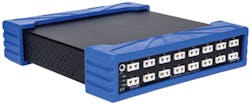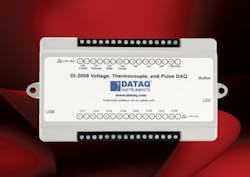Keep cool, calm when making temperature, vibration measurements
Environmental parameters such as temperature and vibration have long been important in industrial applications. What’s changing now is the ability to acquire vast amounts of data, analyze it, and respond in real time, enabling initiatives such as Industry 4.0.1 Companies are offering a variety of approaches to the data-acquisition portion of the process, with offerings spanning just a few channels at low cost to hundreds of channels of synchronized data based on Time Sensitive Networking (TSN).
Addressing the latter category is National Instruments. “Recent trends like the Internet of Things are pushing all of us to a fourth industrial revolution,” said Scott Rust, NI’s senior vice president for global R&D, speaking during a keynote at this year’s NIWeek in May in Austin. Ray Hsu, section manager for IoT software technologies, followed Rust onto the keynote stage and acknowledged that some IoT implementations in the consumer space have come in for derision—for example, the world doesn’t need to hear from your connected toaster. “Clearly not all consumer IoT devices are created equal,” he said. “But on the industrial side, the IoT can add significant value to things that run your business—production machines, operational assets like pumps and motors, and even your connected test systems.”
Hsu continued, “By instrumenting your assets and equipment and connecting them together, your business can realize operational efficiencies that you never imagined were possible—a step function in higher quality, higher yield, and higher levels of safety. Measurements of data at the edge combine to create new insights, and these insights empower just-in-time business decisions. The quality of your measurement and control has a direct impact on the value of your IoT solutions.”
To optimize your industrial IoT systems, Hsu said you’ll need to consider the sophistication of edge nodes and the implementation of centralized management of these nodes. In addition, you’ll need an open architecture to integrate your IIoT devices with enterprise IT systems on the premises or in the cloud.
Industrial monitoring
Ryan Welker, business development manager at Integrated Test + Measurement, joined Hsu on the NIWeek keynote stage and outlined his company’s approach to IIoT. “At ITM we combine industrial monitoring with mechanical test to drive efficiencies in product development, validation, and manufacturing to help our customers reduce cost,” he said, citing as an example a project for a major off-highway equipment manufacturer. “We instrumented a large piece of equipment with 22 CompactDAQ chassis to validate the structural design. We wanted to create an accurate picture of the loads the equipment undergoes while in operation. We use our iTestSystem software, which is built in LabVIEW, to mass-configure over 1,300 channels, and we chose cDAQ so we could connect directly to a mix of different sensors such as strain gauges, accelerometers, and thermocouples.”
Welker said a DAQ system can be pretty straightforward to implement for simple applications, but that signal-based synchronization can create significant challenges when scaling to multiple systems over long distances, as is common in industrial IoT applications. “We spent over 300 man hours installing and troubleshooting power and Ethernet connections between the 22 cDAQ chassis and the synchronization modules and the external network switches,” he said.
Anticipating an NIWeek launch that would help with synchronization, Welker added, “One thing that would make our setup much easier is a simple way to establish a common, accurate notion of time regardless of system size or distance between the nodes.” Taking the cue, Hsu announced the integration of TSN into CompactDAQ with the introduction of the new cDAQ-9185 and cDAQ-9189 multislot Ethernet chassis (Figure 1).
Courtesy of National Instruments
Shelley Gretlein, vice president of corporate marketing at NI, noted that work on defining TSN began in 2012 with the creation of a task force. The opening this year of NI’s Industrial Internet of Things Lab2 promises to further facilitate work on TSN. At NIWeek 2016,3 NI announced an early-access technology platform for TSN, which included new CompactRIO controllers.
Commenting on this year’s extension of TSN to CompactDAQ, Welker said that “…the built-in network switch makes it easy for us to set up and expand our systems with simple daisy-chaining using a single Ethernet cable. This simplifies our network topology, it decreases the need for external hardware, and it removes points of failure from our system—thereby cutting our cabling costs in half and reducing our maintenance labor by up to 80%.”
The new TSN-enabled CompactDAQ chassis provides precise synchronized timing over the network, which eliminates the need for lengthy, physical timing cables and ensures tightly synchronized measurements for accurate analysis. The new chassis support simple daisy chaining through an integrated network switch for quick setup and expansion in distributed applications. They offer reliable operation in harsh environments with -40° to 70°C operating temperature range, shock resistance up to 50 g, and vibration resistance up to 5 g. Software abstraction through the NI-DAQmx driver automatically synchronizes multiple chassis for simple programming.
LXI instrument with PTP
Of course, not every application requires hundreds of time-synchronized channels, and companies have recently introduced several other options for measurement and data acquisition. For example, AMETEK VTI Instruments has introduced an LXI offering, the EX1401 precision 16-channel isolated thermocouple and voltage-measurement instrument (Figure 2). A full-featured embedded web interface provides configuration and data displays, simplifying setup and usage. EXLab Express, VTI’s data-acquisition software, comes with each instrument, eliminating the need for programming.
Courtesy of VTI Instruments
An LXI interface allows the EX1401 to be distributed and positioned close to the device-under-test, reducing the implementation and support costs associated with long cable lengths. That also reduces transducer cable lengths along with associated coupled EMI interference. The EX1401 also supports IEEE 1588 Precision Time Protocol (PTP), allowing engineers to synchronize measurements from many devices throughout the test application.
The EX1401 delivers accuracies of ±0.20°C, 1,000-V channel-channel isolation, built-in self-test capabilities, and independent 24-bit ADCs per channel. Independent cold-junction compensation (CJC)—implemented on a per channel basis—and open thermocouple detection (OTD) further enhance the instrument’s capabilities. Unlike other thermocouple and voltage-measurement instruments, the company said, the EX1401 offers Power over Ethernet+ (PoE+) and flexible DC power options for portable applications. With PoE+, the test engineer does not need to connect both data and power cables.
With the ability to acquire data at 20k samples per second per channel, the EX1401 can be deployed in situations that demand rapid responses to quickly changing conditions, including high-speed temperature transient applications. The EX1401 has application in automotive and battery testing, highly accelerated life test/highly accelerated stress screening (HALT/HASS), and jet engine testing.
From web interface to USB
Other companies having recently released DAQ products include Measurement Computing Corp., which offers the WebDAQ Internet-enabled data loggers (Figure 3). The company said that in an age of mobile applications and connected devices, the ability to access data remotely is more important than ever, noting that the WebDAQ data-logger architecture allows configuration and access to the data using phones, tablets, and laptops with a single user interface. With the WebDAQ embedded web server, users can configure and run simple to complex data-logging operations, log data, set alarm conditions, and view the data in real time.
Courtesy of Measurement Computing Corp.
Each device includes 3 GB of internal storage, an SD card input, and support for USB flash drives, and it can send notifications through email or SMS messages. The WebDAQ 316 temperature logger features 16 thermocouple inputs with up to a 75-S/s sample rate. The WebDAQ 504 vibration/acoustic logger offers four IEPE inputs for direct accelerometer or microphone measurements and a 51-kS/s per channel sample rate. Both models provide 24-bit resolution plus four digital I/O channels for triggering and alarming functions. The company said more models will follow next year.
Ethernet is not your only choice. DATAQ Instruments does offer the Model DI-808 web-based data logger featuring an embedded web server for IoT applications,4 but more recently the company announced the Model DI-2008 USB-connected voltage and thermocouple data-acquisition system (Figure 4). At a price of $62 per analog channel, Model DI-2008 provides 120-VRMS input-to-output and channel-to-channel isolation for each of eight analog channels, expandable to 128 channels. Each analog channel can be independently programmed to measure voltage or thermocouple-based temperatures. Voltage measurements span ±10 mV to ±50 V across 12 programmable measurement ranges. Temperature measurements can be made using any thermocouple type.
Courtesy of DATAQ Instruments
Model DI-2008 also supports pulse and discrete digital I/O capability, where two discrete inputs can be programmed for count and frequency measurements. Channel expansion for both analog and pulse channels is supported through DATAQ Instruments’ ChannelStretch technology. Users can connect up to 16 instruments to a single PC and acquire data synchronously from all to a single file. DI-2008 software support includes ready-to-run WinDaq data acquisition software, a .NET class, ActiveX controls, and a fully documented communication protocol.
Automotive applications
Finally, Diversified Technical Systems (DTS) announced that it will exhibit its new SLICE IP68 data-acquisition system at the Automotive Testing Expo October 24-26 in Novi, MI. Targeted at applications with size or mass constraints, SLICE IP68’s 60 x 60-mm footprint makes it easy to embed in most test articles, the company said, adding that the rugged housing is impervious to shock, water, and dust.
SLICE supports data direct-writes to 16 GB of internal flash memory and features onboard signal conditioning, supporting a variety of external sensors including bridge and IEPE transducers for gathering critical measurements such acceleration, displacement, strain, pressure, and temperature. See p. 6 for more on the Automotive Testing Expo.
References
- Nelson, Rick, “Smart factories leverage cloud, edge computing,” EE-Evaluation Engineering, June 2017, p. 14.
- Nelson, Rick, “NI debuts Industrial IoT Lab to promote innovation and collaboration,” EE-Evaluation Engineering Online, January 11, 2017.
- Nelson, Rick, “Time-sensitive networking, MIMO test take center stage,” Rick’s Blog, EE-Evaluation Engineering Online, August 9, 2016.
- “Product Picks,” EE-Evaluation Engineering, January 2017, p. 26.
For more information:
About the Author

Rick Nelson
Contributing Editor
Rick is currently Contributing Technical Editor. He was Executive Editor for EE in 2011-2018. Previously he served on several publications, including EDN and Vision Systems Design, and has received awards for signed editorials from the American Society of Business Publication Editors. He began as a design engineer at General Electric and Litton Industries and earned a BSEE degree from Penn State.




